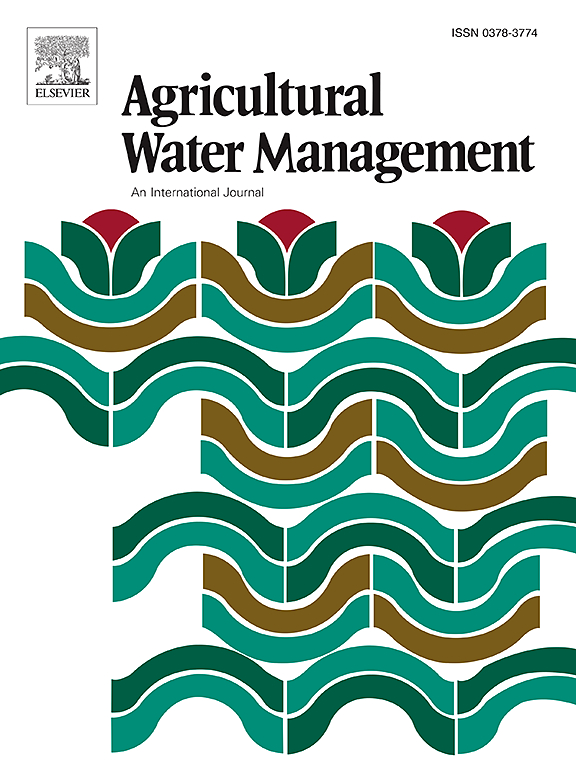通过岩溶石漠化斜坡上的石芽和卡伦收集雨水并进行灌溉:应用和效益分析
IF 5.9
1区 农林科学
Q1 AGRONOMY
引用次数: 0
摘要
地表水缺乏是导致岩溶地区农业干旱的一个关键因素,并加剧了以基岩裸露率高为特征的岩溶石漠化。石芽岩溶(SBK)是一种由裸露基岩和沟谷组成的独特岩溶地貌类型,具有不透水、集径流、分布广等特点,在解决农业灌溉缺水问题上具有巨大潜力,尤其是在中国贵州省雨量丰富的岩溶地区。我们利用无人机图像识别 SBK,并利用实测降雨径流数据进行验证,将 SBK 作为基本单元应用于石漠化边坡的降雨集水,并分析了通过 SBK 集水灌溉的效益。结果如下(1)利用地形开差和洼地填充耦合方法识别石漠化坡面的卡伦,SBK模拟径流的平均NSE和R2分别为0.82和0.86,RMSE和RSR分别小于0.03 m3和0.51。(2)SBK 的裸露基岩利用率和集雨系数分别为 0.62 和 0.55,在 90%、80% 和 50%的灌溉条件下,裸露基岩与满足灌溉需水的耕地面积比分别达到 1:3.1、1:3.7 和 1:7.0。(3) 在岩溶地区,作物在降雨后一周内就会面临干旱,采用 SBK 集雨灌溉可有效避免作物歉收,而且成本在当地农民可承受范围内,对环境的破坏也有限。使用 SBK 收集雨水还可以缓解岩溶地区因降雨时间分布不均和工程缺水等问题造成的地表水短缺。因此,SBK 在缓解岩溶石漠化地区农业干旱方面具有很强的应用潜力。本文章由计算机程序翻译,如有差异,请以英文原文为准。
Rainfall water collection and irrigation via stone bud and karren on karst rocky desertification slopes: Application and benefit analysis
Lack of surface water is a key factor leading to agricultural drought in karst regions and exacerbates the karst rocky desertification, which is characterized by high rate of exposed bedrock. With the characteristics of impermeability, runoff collection, and wide distribution, stone bud and karren (SBK), a unique karst landscape type composed of exposed bedrock and gullies, has a great potential to solve water shortage in agricultural irrigation, especially in the rain-rich karst regions of Guizhou Province, China. Using unmanned aerial vehicle images to identify SBK and measured rainfall–runoff data for validation, we applied SBK as a basic unit to harvest rainfall water on rocky desertification slopes and analyzed the benefits of rainfall water collection and irrigation via SBK. The results showed the following: (1) Karrens on rocky desertification slopes could be identified using a method coupling terrain opening difference and depression filling, and the simulated runoff on SBK could achieved the average NSE and R2 of 0.82 and 0.86, with RMSE and RSR less than 0.03 m3 and 0.51, respectively. (2) The exposed bedrock utilization rate and rainfall water collection coefficient of SBK were 0.62 and 0.55, respectively, such that the area ratio of exposed bedrock to the cultivated land meeting irrigation water demand reached 1:3.1, 1:3.7 and 1:7.0 under 90 %, 80 % and 50 % possibilities of irrigation. (3) Implementing SBK for rainfall water harvesting and irrigation could efficiently avoid crop failure in the karst regions where crops faced drought within only one week after rainfall, and was at an affordable cost to local farmers with limited environmental damage. The use of SBK to harvest rainfall water could also alleviate surface water shortages in karst regions caused by problems such as uneven temporal distribution of rainfall and engineering water shortages. Consequently, SBK demonstrate a strong application potential to alleviate agricultural drought in karst rocky desertification regions.
求助全文
通过发布文献求助,成功后即可免费获取论文全文。
去求助
来源期刊

Agricultural Water Management
农林科学-农艺学
CiteScore
12.10
自引率
14.90%
发文量
648
审稿时长
4.9 months
期刊介绍:
Agricultural Water Management publishes papers of international significance relating to the science, economics, and policy of agricultural water management. In all cases, manuscripts must address implications and provide insight regarding agricultural water management.
 求助内容:
求助内容: 应助结果提醒方式:
应助结果提醒方式:


